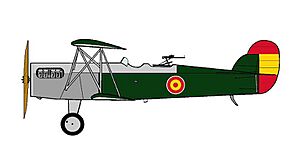Eduardo Barrón facts for kids
Quick facts for kids
Eduardo Barrón
|
|
|---|---|
| Born | 7 September 1888 |
| Died | 13 January 1949 (aged 60) |
| Nationality | Spanish |
| Occupation | Engineer |
| Engineering career | |
| Projects | Barron Flecha Barron W Loring R-I Loring R-III |
| Awards | Order of Charles III |
Eduardo Barrón was a Spanish aeronautical engineer and military pilot. He was born on September 7, 1888, and passed away on January 13, 1949. Barrón led the design team at Talleres Loring, a company that built airplanes, from 1923 to 1930.
Contents
Eduardo Barrón's Early Life and Training
Eduardo Barrón was born in Cuba in 1888. His family moved to Spain when he was young. They settled in Madrid. In 1902, he began studying at the Academy of Military Engineering of Guadalajara. By 1907, he became a junior officer.
In 1908, Barrón joined a special unit that worked with aerostats, which are like large balloons used for observation. He became a certified balloon pilot in 1909. His unit then went to North Africa, where he took part in military activities between 1909 and 1910.
Becoming a Military Pilot
In 1911, Barrón returned to Spain. He was chosen to become an aircraft pilot. He was among the first military pilots in Spain. The next year, he became a Captain in the new Aeronautics section. This section was separate from the balloon unit.
In 1913, Barrón was sent to an airfield in Tétouan. He was in charge of new Lohner B.I aircraft bought from Austria-Hungary. He flew missions to observe areas and drop light bombs.
Designing Spain's First Airplanes
In 1914, Barrón moved to Cuatro Vientos near Madrid. He started working at a new military workshop that built aircraft. He changed the Lohner biplanes to create a new model. This plane was called Barrón Flecha. It is known as the first step for Spain's aircraft industry.
The Flecha flew for the first time in April 1915. Later, Barrón added a stronger engine to it. He showed the plane to King Alfonso XIII in July. Because it was successful, a company built twelve Flecha planes.
Improving Aircraft Designs
Barrón kept working on the Flecha prototype. He made a new model with better visibility for the pilot. He named this plane Barrón W. Twelve of these Barrón W planes were built.
He also visited France to study how the SPAD S.VII plane was built. He then created his own version, which he called España. A company was asked to build twelve Barrón España planes. However, these planes had serious problems and were never used by the military.
In 1917, Barrón left the military for a while. He became the head of the aviation part of 'La Hispano' company. He designed two planes for them in 1918: a reconnaissance plane (for observing) and a fighter plane. These were called the Hispano Barrón. But after World War I, many cheap and advanced planes were available. This made it hard for new local aircraft to be developed.
Barrón returned to the military in 1920. He was promoted to commander in 1921. He was put in charge of the workshops and stores at Cuatro Vientos. In 1922, he moved to Seville and became the chief of the military airbase there.
Leading Engineer at Talleres Loring
Barrón returned to Cuatro Vientos to become the chief engineer at a new airplane factory called Talleres Loring. This company had a contract to build Fokker C.IV reconnaissance planes.
While at Loring, Barrón designed and tested his own planes. His first project was the Loring RB. His next project was the Loring R.I. This plane was for reconnaissance and light bombing. Thirty of these planes were built for the Spanish Army.
Based on the R.I, he designed the Loring R-III. This plane had similar features but a different engine. A total of 110 Loring R-III planes were built. They were delivered to the military starting in 1929.
Other Airplane Projects
Even though the Spanish aircraft industry was doing well, some of Barrón's other plane designs stayed as prototypes. These included:
- The Loring R-II
- The Loring C-I fighter
- The Loring T.1 trainer
- The Loring E.II light plane
A changed version of the E.II, called La Pepa, was used by Fernando Rein Loring in 1932. He flew it alone from Madrid to Manila.
In 1930, Barrón became ill and had to stop working at Loring. A prototype of his Loring T-3 commercial plane was built in 1931. Other designs, like a large bomber, remained as ideas.
Later Life and Achievements
In 1931, Eduardo Barrón retired. The new Spanish government gave him a good pension. He also finally received his official aeronautical engineer title. Before this, he had been doing successful engineering work without the formal degree. Around this time, the Loring company started having money problems.
Barrón moved to Seville in 1933. In July 1936, when a difficult time began in Spain, he was asked to help adapt local industries for the war effort. After the conflict ended, he was promoted to the rank of colonel in the Aeronautical Engineers. In 1944, he became an inspector in a general department. He moved to Madrid and became a general in 1945. He passed away in Madrid in 1949 after another illness.
See also
 In Spanish: Eduardo Barrón y Ramos de Sotomayor para niños
In Spanish: Eduardo Barrón y Ramos de Sotomayor para niños
- List of Interwar military aircraft



